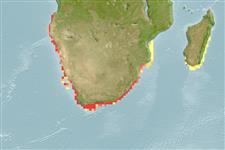>
Eupercaria/misc (Various families in series Eupercaria) >
Sparidae (Porgies)
Etymology: Rhabdosargus: Greek, rhabdos = stick + Latin, sargus = sargus (1591) (Ref. 45335).
More on author: Valenciennes.
Environment: milieu / climate zone / depth range / distribution range
Ecologia
marino; salmastro benthopelagico; oceanodromo (Ref. 51243); distribuzione batimetrica ? - 100 m (Ref. 3198). Tropical; 13°S - 36°S
Southeast Atlantic: Angola southward around coast of South Africa to Natal. Reported from Mozambique (Ref. 5213).
Length at first maturity / Size / Peso / Age
Maturity: Lm 23.0, range 22 - 24 cm
Max length : 65.0 cm TL maschio/sesso non determinato; (Ref. 3688); common length : 40.0 cm TL maschio/sesso non determinato; (Ref. 3688)
Spine dorsali (totale): 11; Raggi dorsali molli (totale): 11-13; Spine anali 3; Raggi anali molli: 10 - 11. Silvery with distinct crossbars (Ref. 3198).
Found over sandy substrate. Juveniles use estuaries as nurseries (Ref. 27121). Feeds on worms, crustaceans, and mollusks especially mussels (Ref. 5213). Spawns during spring and summer close inshore (Ref. 36731).
Life cycle and mating behavior
Maturità | Riproduzione | Deposizione | Uova | Fecundity | Larve
Conflicting descriptions of the reproductive style of this species have been reported, e.g., Ref. 4359 describe this species as being a gonochorist (Ref. 28504). Also Ref. 103751.
Bauchot, M.-L. and J.-C. Hureau, 1990. Sparidae. p. 790-812. In J.C. Quero, J.C. Hureau, C. Karrer, A. Post and L. Saldanha (eds.) Check-list of the fishes of the eastern tropical Atlantic (CLOFETA). JNICT, Lisbon; SEI, Paris; and UNESCO, Paris. Vol. 2. (Ref. 3688)
IUCN Red List Status (Ref. 130435)
Threat to humans
Harmless
Human uses
Pesca: scarso interesse commerciale; Pesce da pesca sportiva: si
Informazioni ulteriori
BibliografiaAcquacolturaProfilo di acquacolturaVarietàGeneticaElectrophoresesEreditarietàMalattieElaborazioneNutrientsMass conversion
CollaboratoriImmaginiStamps, Coins Misc.SuoniCiguateraVelocitàModalità di nuotoArea branchialeOtolithsCervelliVista
Strumenti
Special reports
Download XML
Fonti Internet
Estimates based on models
Preferred temperature (Ref.
123201): 14.5 - 26.4, mean 23.8 °C (based on 102 cells).
Phylogenetic diversity index (Ref.
82804): PD
50 = 0.5156 [Uniqueness, from 0.5 = low to 2.0 = high].
Bayesian length-weight: a=0.01259 (0.00609 - 0.02604), b=3.04 (2.87 - 3.21), in cm total length, based on LWR estimates for this (Sub)family-body shape (Ref.
93245).
Trophic level (Ref.
69278): 3.0 ±0.2 se; based on diet studies.
Generation time: 6.9 ( na - na) years. Estimated as median ln(3)/K based on 1
growth studies.
Resilienza (Ref.
120179): Medio, tempo minimo di raddoppiamento della popolazione 1.4 - 4.4 anni (K=0.16).
Fishing Vulnerability (Ref.
59153): Moderate to high vulnerability (54 of 100).
Climate Vulnerability (Ref.
125649): Moderate to high vulnerability (48 of 100).
Nutrients (Ref.
124155): Calcium = 72.5 [39.7, 137.6] mg/100g; Iron = 0.8 [0.4, 1.5] mg/100g; Protein = 18.4 [17.3, 19.5] %; Omega3 = 0.232 [0.139, 0.391] g/100g; Selenium = 65.5 [32.2, 121.5] μg/100g; VitaminA = 22.4 [7.0, 57.1] μg/100g; Zinc = 1.46 [1.01, 2.07] mg/100g (wet weight);
